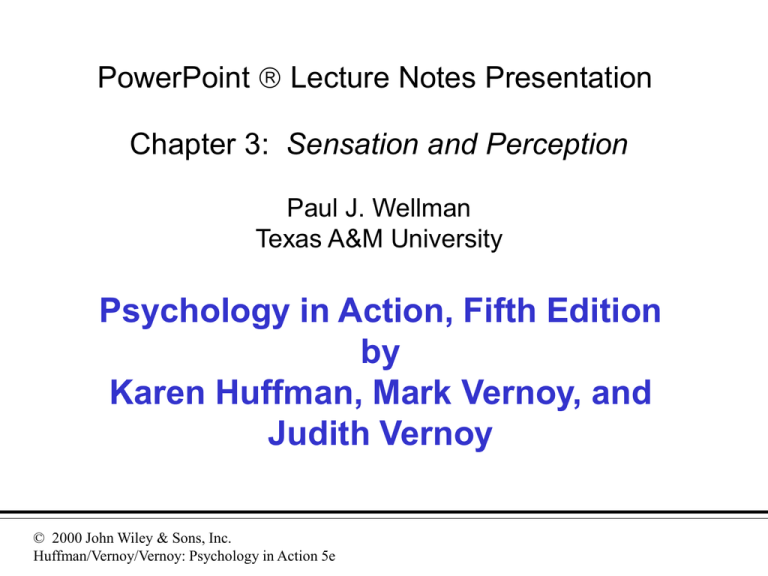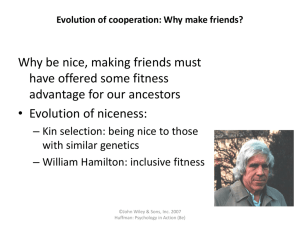
PowerPoint Lecture Notes Presentation
Chapter 3: Sensation and Perception
Paul J. Wellman
Texas A&M University
Psychology in Action, Fifth Edition
by
Karen Huffman, Mark Vernoy, and
Judith Vernoy
© 2000 John Wiley & Sons, Inc.
Huffman/Vernoy/Vernoy: Psychology in Action 5e
Lecture Overview
•
•
•
•
Experiencing Sensations
Vision
Other Senses
Perception
– Selection
– Organization
– Interpretation
© 2000 John Wiley & Sons, Inc.
Huffman/Vernoy/Vernoy: Psychology in Action 5e
Sensation and Perception
• Sensation is the process of receiving,
converting, and transmitting information
from the outside world
– Sensory organs contain receptors that
transduce sensory energy into nerve
impulses that are carried to the brain
• Perception involves organization and
interpretation of sensory input
© 2000 John Wiley & Sons, Inc.
Huffman/Vernoy/Vernoy: Psychology in Action 5e
Sensory Thresholds
• Each sense has a threshold level of
energy required to activate that sense
– Absolute threshold: The smallest amount
of energy that can be detected
– Difference threshold: The smallest
difference in sensory energies that can be
detected
© 2000 John Wiley & Sons, Inc.
Huffman/Vernoy/Vernoy: Psychology in Action 5e
Vision
• External light falls on receptors within the
eye to generate the visual message
• Light = electromagnetic radiation
– Wavelength determines color
© 2000 John Wiley & Sons, Inc.
Huffman/Vernoy/Vernoy: Psychology in Action 5e
Anatomy of the Eye
© 2000 John Wiley & Sons, Inc.
Huffman/Vernoy/Vernoy: Psychology in Action 5e
Photoreceptors
• Photoreceptors are light sensitive cells
found within the retina
– Rods are sensitive to light but not color, are
active under low-light conditions
– Cones are sensitive to color, are not active
in low-light conditions, allow for fine detail
– Rods and cones use different
photopigments that react to light so as to
generate nerve potentials
© 2000 John Wiley & Sons, Inc.
Huffman/Vernoy/Vernoy: Psychology in Action 5e
Retinal Photoreceptors
© 2000 John Wiley & Sons, Inc.
Huffman/Vernoy/Vernoy: Psychology in Action 5e
Sensory Coding
• Activation of
retinal cells by
light results in
action potentials
that travel along
neurons that
project to the
occipital cortex
© 2000 John Wiley & Sons, Inc.
Huffman/Vernoy/Vernoy: Psychology in Action 5e
Hearing
• Receptors within the ear are tuned to
detect sound waves (changes in sound
pressure)
– Sound waves show
• Frequency: corresponds to pitch
• Amplitude: corresponds to loudness
• Sound loudness is measured in
decibels
© 2000 John Wiley & Sons, Inc.
Huffman/Vernoy/Vernoy: Psychology in Action 5e
Sound Loudness (dB)
© 2000 John Wiley & Sons, Inc.
Huffman/Vernoy/Vernoy: Psychology in Action 5e
Anatomy of the Ear
(Sound Waves)
© 2000 John Wiley & Sons, Inc.
Huffman/Vernoy/Vernoy: Psychology in Action 5e
Pitch and Loudness
• Sound waves vibrate the basilar
membrane within the cochlea of the ear
– Hair cells containing receptors bend in
response to vibration of the membrane
– Hair cells trigger action potentials that are
carried to the auditory cortex
– Different frequencies produce maximal
vibration of different areas along the
membrane: produces place coding of pitch
© 2000 John Wiley & Sons, Inc.
Huffman/Vernoy/Vernoy: Psychology in Action 5e
Perception
• Sensation refers to detection and
transduction of sensory stimuli
• Perceptual process include
– Selection
– Organization
– Interpretation
• Perceptions may not match sensations
– Illusions are an example
© 2000 John Wiley & Sons, Inc.
Huffman/Vernoy/Vernoy: Psychology in Action 5e
Horizontal-Vertical Illusion
WHICH LINE IS LONGER?
© 2000 John Wiley & Sons, Inc.
Huffman/Vernoy/Vernoy: Psychology in Action 5e
Form Perception
• Figure and background are basic
organizational themes for perception
• Gestalt psychologists examined
properties that make for a good figure
– Figure is perceived as distinct from the
background
– Figure is closer to the viewer than the
background
© 2000 John Wiley & Sons, Inc.
Huffman/Vernoy/Vernoy: Psychology in Action 5e
Gestalt Organizational Principles
© 2000 John Wiley & Sons, Inc.
Huffman/Vernoy/Vernoy: Psychology in Action 5e
Color Perception
• Trichromatic theory
– Eye contains 3 different color sensitive
elements
• Blue, green or red elements
• Trichromatic theory accounts for color mixing of
lights
• Opponent-Process theory
– Visual system is organized into red-green,
blue-yellow and black-white units
• Accounts for negative color afterimages
© 2000 John Wiley & Sons, Inc.
Huffman/Vernoy/Vernoy: Psychology in Action 5e
Extrasensory Perception
• ESP refers to the ability to perceive
stimuli that are outside the 5 senses
– Telepathy: the ability to read minds
– Clairvoyance: the ability to perceive objects
or events
– Precognition: the ability to predict the future
– Psychokinesis: the ability to move objects
© 2000 John Wiley & Sons, Inc.
Huffman/Vernoy/Vernoy: Psychology in Action 5e
Copyright
Copyright 2000 by John Wiley and Sons, New York,
NY. All rights reserved. No part of the material
protected by this copyright may be reproduced or
utilized in any form or by any means, electronic or
mechanical, including photocopying, recording, or by
any information storage and retrieval system, without
written permission of the copyright owner.
© 2000 John Wiley & Sons, Inc.
Huffman/Vernoy/Vernoy: Psychology in Action 5e







